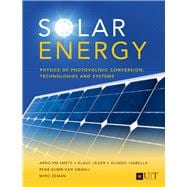This book uniquely covers both the physics of photovoltaic (PV) cells and the design of PV systems for real-life applications, including:
- The fundamental principles of semiconductor solar cells.
- PV technology: crystalline silicon solar cells; thin-film cells; PV modules; third-generation concepts.
- PV systems, from simple stand-alone to complex systems connected to the grid; components; design; deployment; performance.
The book is an invaluable reference for researchers, industrial engineers and designers working in solar energy generation. The book is also ideal for university and third-level physics or engineering courses on solar photovoltaics, with exercises to check students’ understanding and reinforce learning. It is the perfect companion to the Massive Open Online Course (MOOC) on Solar Energy (DelftX, ET.3034TU) presented by co-author Arno Smets. The course is available in English on the nonprofit open source edX.org platform, and in Arabic on edraak.org. Over 100,000 students have already registered for these MOOCs.








